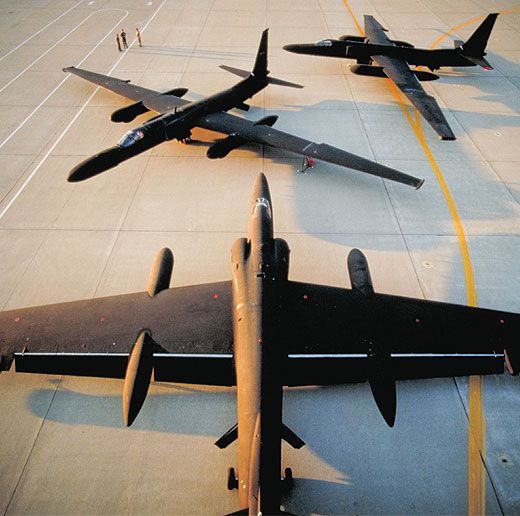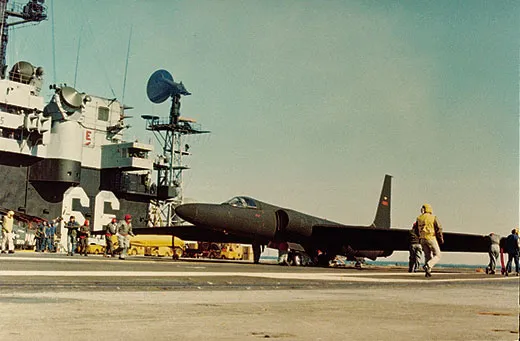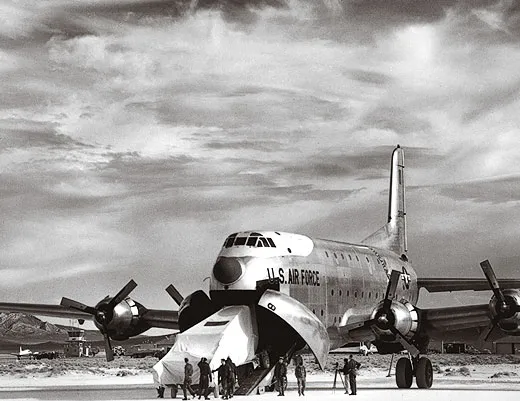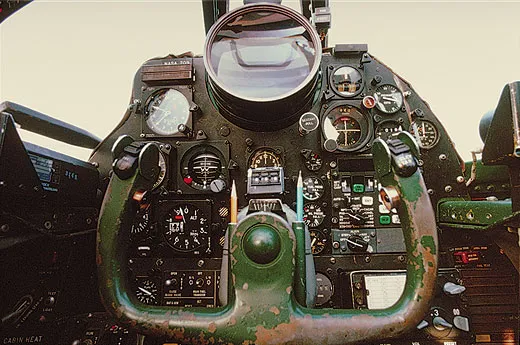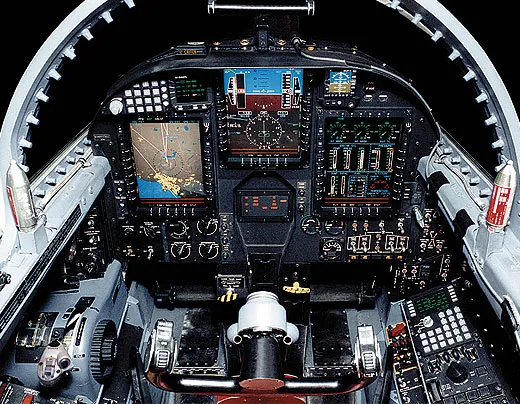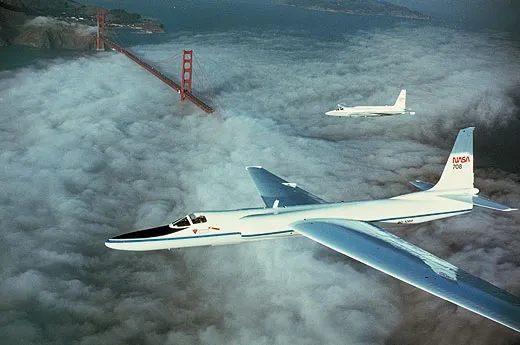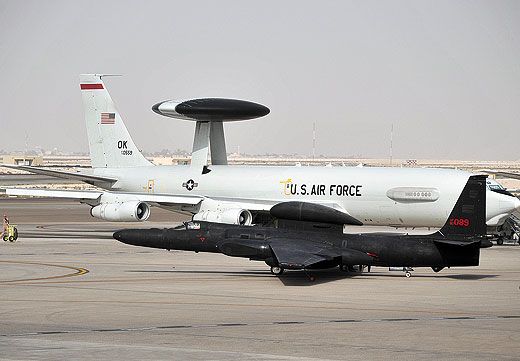Diary of a Spy
Events that made the U-2 the world’s most famous player in the game of espionage.
:focal(402x147:403x148)/https://tf-cmsv2-smithsonianmag-media.s3.amazonaws.com/filer/U-2-diary-flash.jpg)
To Lockheed Skunk Works aeronautical engineer Clarence “Kelly” Johnson, the super-secret spyplane he designed in the mid-1950s was “Angel.” To the Central Intelligence Agency, which used it extensively during the cold war, it was “Article.” To the rest of the world, which learned of its existence when the Soviet Union shot one down in 1960 and forced the U.S. government’s hand, it was a marvel. The Lockheed U-2 could fly at 70,000 feet—higher than any other aircraft had flown. On missions that stretched 6,400 miles, it could photograph secret bases and hidden missile sites while eluding enemy fighter aircraft, if not always surface-to-air missiles.
On its most famous spy mission, it spotted Soviet nuclear missiles deployed 90 miles from Key West, Florida, a 1962 sighting that touched off the Cuban Missile Crisis. Since that time, it has for the most part matched its high altitude with a low profile, surreptitiously watching the enemy in virtually every U.S. conflict from the Vietnam War to Iraq. But the Dragon Lady is a difficult airplane to handle. And Air Force pilots flying the U-2 today to gather intelligence on insurgents in Afghanistan are flying longer, more stressful missions than those who flew the first variant, nearly 60 years ago.
FOR THE U-2, the 1960s began inauspiciously. On May 1, 1960, pilot Francis Gary Powers, flying a U-2 mission as part of a joint operation between the Air Force and the CIA, was shot down over Sverdlovsk in the Soviet Union and taken prisoner. The incident forced the United States to ramp up another way to get reconnaissance: the Corona satellite program. (Powers was later exchanged for Soviet spy Vilyam Fisher, also known as Rudolf Abel.)
But satellites couldn’t go where the U-2 could. In 1964, the spyplane gave the CIA a detailed look at France’s new nuclear test site at Mururoa Atoll in French Polynesia. (France had picked the remote South Pacific atoll to replace its test site in Algeria after that country became independent.)
As the Vietnam War intensified, U-2s started flying in Southeast Asia to detect Viet Cong forces. Both the CIA and the U.S. Air Force were increasingly flying the Dragon Lady over Cambodia, Laos, and the two Vietnams (in 1964, the Air Force took over all U-2 flights over Southeast Asia, and the CIA focused on China). Until 1968, Nationalist Chinese pilots in Taiwan flew the U-2 over mainland China to monitor military activity (see “Lin Xu’s Obsession”).
In 1964, with foreign governments increasingly reluctant to allow basing and overflight rights, the CIA began flying the U-2 off of and onto aircraft carriers. That operation, dubbed Project Whale Tale, lasted about a decade. In August 1974, the CIA handed off all U-2 operations to the Air Force.
THE END OF THE VIETNAM WAR brought a new mission for the U-2: Take over from drones and DC-130s the airborne monitoring of communications from North Korea. In May 1974, not long after the flights over North Korea began, the U-2 flew its last mission over Cuba. The Air Force handed off that duty to the Lockheed SR-71 Blackbird.
During the 1970s, U-2s were dispatched to the Middle East to monitor the Arab-Israeli ceasefire, and Somalia, where the Soviets had set up a naval base.
But the aircraft also flew humanitarian missions, supplying aerial photography to the government of Guatemala after an earthquake ravaged that country in February 1976. Five stunningly sharp images were released to the U.S. media, writes Chris Pocock in 50 Years of the U-2: The Complete Illustrated History of the Dragon Lady, “[and] the publicity left a lasting and favorable impression of the aircraft.”
NASA got a pair of the airplanes in 1971 to conduct Earth surveys. (It replaced them a decade later with the Earth Resources version of the U-2, Lockheed’s ER-2.) Based at Dryden Flight Research Center in California, NASA’s U-2s and ER-2s have flown more than 4,500 data missions and test flights.
BY 1980, the U-2 fleet had a new home—Beale Air Force Base near Marysville, California, joining the Blackbird in the Ninth Reconnaissance Wing. The tension was apparent, wrote Ernest Gann in his 1989 book The Black Watch: “There is often a certain condescension in the manner of SR-71 pilots and their ‘backseaters.’ They are inclined to regard the U-2 as a work mule, with a speed to match that animal.
“The reaction of the U-2 people is hardly surprising…they refer to the SR-71 as the ‘sled,’ and since the sled drivers seem to make a more romantic impression on the public, they are said to deliberately fly towards thunderstorms because they mistake them for camera flashbulbs,” Gann wrote. Ultimately, U-2 pilots had the last laugh: The Blackbird was retired in 1999, while the Dragon Lady continues to fly.
The U-2 also got a new name—TR-1—after going into production for the third time. The spyplane was essentially the same as the second variant, the U-2R, but was updated for tactical reconnaissance (hence the “TR”) so it could do high-altitude surveillance of Eastern Europe. The new Dragon Lady featured state-of-the-art cameras and sensors that could peer 300 miles from the aircraft, an advanced imaging radar, and a precision locator to detect enemy radar and surface-to-air-missile sites.
The first TR-1 flew in August 1981, and was first deployed overseas in February 1983.
IT WASN’T LONG BEFORE the U-2 was back in combat. After Iraq invaded Kuwait in August 1990, the Air Force sent the Dragon Lady on photo-reconnaissance missions that imaged most of Iraq, including Baghdad. Included were locations of surface-to-air missile sites. Once the air war began in January 1991, a U-2 was the first aircraft to fly across the Iraqi border; it imaged fixed Scud missile sites at air fields and later recorded bomb damage from the initial F-117 attacks.
According to Air Force assessments, the U-2 provided more than half of all imagery intelligence and 90 percent of the Army’s targeting intelligence against Iraq. “So much for reconnaissance satellites,” writes Pocock. “They were often defeated by haze, smoke, or bad weather, and when they did take useful images, the product was simply not available to the right people at the right time.”
Later in the decade, the U-2 patrolled the conflicts in Bosnia and Kosovo and monitored the no-fly zones in northern and southern Iraq.
WITH THE NEW CENTURY came modernization. The biggest upgrade for the aircraft was a glass cockpit: three large screens replaced the dials and switches that had been in place since the first flight of the U-2R in 1967. The touch controls were positioned so a pilot wearing the bulky high-pressure suit gloves could easily use them.
After the September 11, 2001 terrorist attacks, the U-2 was called to assist in the invasion of Afghanistan by supplying allied ground forces with maps of the terrain. This time the Dragon Lady had company: the Global Hawk and Predator unmanned aerial vehicles. Early in the U-2’s career, some thought the airplane would be replaced by satellites; now the threat was the Global Hawk. But this past January, the Air Force announced that the U-2 would continue to fly surveillance missions because the Global Hawk’s costs kept escalating.
The U.S. invasion of Iraq in March 2003 marked the U-2’s biggest deployment yet, with at least 15 jets flown by 31 pilots on 169 missions. U-2 pilots were flying every three to four days on missions that averaged 10 to 11 hours.
Today, the U-2 is still flying over Afghanistan, and is expected to fly until around 2023. In the late 1990s, Lockheed Martin performed stress tests on some U-2s to determine the fatigue of the airframes. It turned out that the Dragon Lady has a long fatigue life—75,000 hours—mostly due to its lengthy loiter time at high altitudes, where turbulence is minimal. Even the highest-time U-2 airframes, according to Pocock, are only just approaching 30,000 hours.
Paul Hoversten is the executive editor at Air & Space/Smithsonian.
